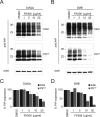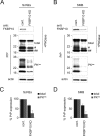Inhibition of the FKBP family of peptidyl prolyl isomerases induces abortive translocation and degradation of the cellular prion protein
- PMID: 26764098
- PMCID: PMC4803302
- DOI: 10.1091/mbc.E15-10-0729
Inhibition of the FKBP family of peptidyl prolyl isomerases induces abortive translocation and degradation of the cellular prion protein
Abstract
Prion diseases are fatal neurodegenerative disorders for which there is no effective treatment. Because the cellular prion protein (PrP(C)) is required for propagation of the infectious scrapie form of the protein, one therapeutic strategy is to reduce PrP(C) expression. Recently FK506, an inhibitor of the FKBP family of peptidyl prolyl isomerases, was shown to increase survival in animal models of prion disease, with proposed mechanisms including calcineurin inhibition, induction of autophagy, and reduced PrP(C) expression. We show that FK506 treatment results in a profound reduction in PrP(C) expression due to a defect in the translocation of PrP(C) into the endoplasmic reticulum with subsequent degradation by the proteasome. These phenotypes could be bypassed by replacing the PrP(C) signal sequence with that of prolactin or osteopontin. In mouse cells, depletion of ER luminal FKBP10 was almost as potent as FK506 in attenuating expression of PrP(C). However, this occurred at a later stage, after translocation of PrP(C) into the ER. Both FK506 treatment and FKBP10 depletion were effective in reducing PrP(Sc) propagation in cell models. These findings show the involvement of FKBP proteins at different stages of PrP(C) biogenesis and identify FKBP10 as a potential therapeutic target for the treatment of prion diseases.
© 2016 Stocki et al. This article is distributed by The American Society for Cell Biology under license from the author(s). Two months after publication it is available to the public under an Attribution–Noncommercial–Share Alike 3.0 Unported Creative Commons License (http://creativecommons.org/licenses/by-nc-sa/3.0).
Figures







Similar articles
-
The retention of prion protein in the endoplasmic reticulum prevents N2A cells from proteasome inhibition-induced cytotoxicity.Biochem Biophys Res Commun. 2017 Sep 16;491(2):500-507. doi: 10.1016/j.bbrc.2017.06.176. Epub 2017 Jun 29. Biochem Biophys Res Commun. 2017. PMID: 28669732
-
Selective re-routing of prion protein to proteasomes and alteration of its vesicular secretion prevent PrP(Sc) formation.J Neurochem. 2007 Jun;101(6):1516-26. doi: 10.1111/j.1471-4159.2006.04439.x. J Neurochem. 2007. PMID: 17542810
-
Scrapie-like prion protein is translocated to the nuclei of infected cells independently of proteasome inhibition and interacts with chromatin.J Cell Sci. 2004 May 1;117(Pt 11):2411-6. doi: 10.1242/jcs.01094. J Cell Sci. 2004. PMID: 15126640
-
The highways and byways of prion protein trafficking.Trends Cell Biol. 2005 Feb;15(2):102-11. doi: 10.1016/j.tcb.2004.12.002. Trends Cell Biol. 2005. PMID: 15695097 Review.
-
Strategies for eliminating PrP(c) as substrate for prion conversion and for enhancing PrP(Sc) degradation.Vet Microbiol. 2007 Aug 31;123(4):377-86. doi: 10.1016/j.vetmic.2007.04.006. Epub 2007 Apr 8. Vet Microbiol. 2007. PMID: 17493775 Review.
Cited by
-
Naegleria fowleri: Protein structures to facilitate drug discovery for the deadly, pathogenic free-living amoeba.PLoS One. 2021 Mar 24;16(3):e0241738. doi: 10.1371/journal.pone.0241738. eCollection 2021. PLoS One. 2021. PMID: 33760815 Free PMC article.
-
Functional genomics screen identifies proteostasis targets that modulate prion protein (PrP) stability.Cell Stress Chaperones. 2021 Mar;26(2):443-452. doi: 10.1007/s12192-021-01191-8. Epub 2021 Feb 5. Cell Stress Chaperones. 2021. PMID: 33547632 Free PMC article.
-
Tacrolimus alleviates LPS-induced AKI by inhibiting TLR4/MyD88/NF-κB signalling in mice.J Cell Mol Med. 2022 Jan;26(2):507-514. doi: 10.1111/jcmm.17108. Epub 2021 Dec 9. J Cell Mol Med. 2022. PMID: 34889045 Free PMC article.
-
Melatonin inhibits Japanese encephalitis virus replication and neurotoxicity via calcineurin-autophagy pathways.BMC Neurosci. 2023 Nov 6;24(1):59. doi: 10.1186/s12868-023-00832-1. BMC Neurosci. 2023. PMID: 37932682 Free PMC article.
-
The Emerging Roles of Early Protein Folding Events in the Secretory Pathway in the Development of Neurodegenerative Maladies.Front Neurosci. 2017 Feb 7;11:48. doi: 10.3389/fnins.2017.00048. eCollection 2017. Front Neurosci. 2017. PMID: 28223916 Free PMC article. Review.
References
-
- Barnes AM, Cabral WA, Weis M, Makareeva E, Mertz EL, Leikin S, Eyre D, Trujillo C, Marini JC. Absence of FKBP10 in recessive type XI osteogenesis imperfecta leads to diminished collagen cross-linking and reduced collagen deposition in extracellular matrix. Hum Mutat. 2012;33:1589–1598. - PMC - PubMed
-
- Brandner S, Isenmann S, Raeber A, Fischer M, Sailer A, Kobayashi Y, Marino S, Weissmann C, Aguzzi A. Normal host prion protein necessary for scrapie-induced neurotoxicity. Nature. 1996;379:339–343. - PubMed
-
- Bueler H, Aguzzi A, Sailer A, Greiner RA, Autenried P, Aguet M, Weissmann C. Mice devoid of PrP are resistant to scrapie. Cell. 1993;73:1339–1347. - PubMed
Publication types
MeSH terms
Substances
Grants and funding
LinkOut - more resources
Full Text Sources
Other Literature Sources
Research Materials

